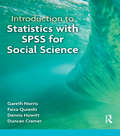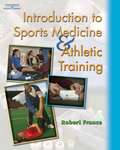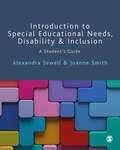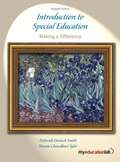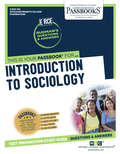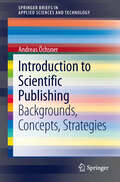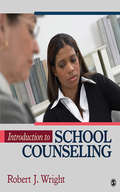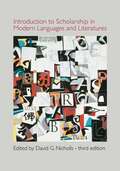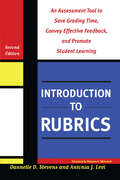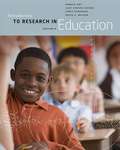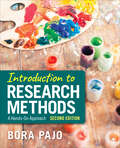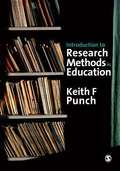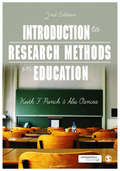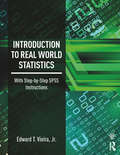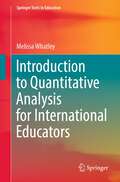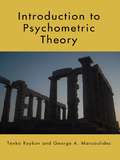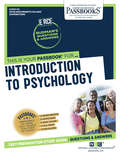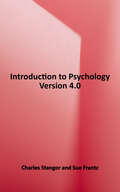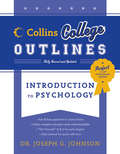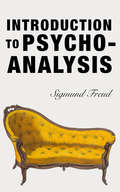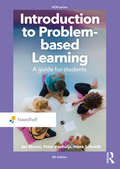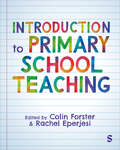- Table View
- List View
Introduction to Statistics with SPSS for Social Science
by Dennis Howitt Duncan Cramer Gareth Norris Faiza QureshiThis is a complete guide to statistics and SPSS for social science students. Statistics with SPSS for Social Science provides a step-by-step explanation of all the important statistical concepts, tests and procedures. It is also a guide to getting started with SPSS, and includes screenshots to illustrate explanations. With examples specific to social sciences, this text is essential for any student in this area.
Introduction to Sports Medicine and Athletic Training
by Robert C. FranceIntroduction to Sports Medicine & Athletic Training is a book written for individuals interested in athletics and the medical needs of athletes. This book is unique in that it covers four distinct disciplines in an easy to understand format. The four disciplines covered include: Sports Medicine, Athletic Training, Anatomy, and Physiology. This all-in-one resource allows the individual to grasp the concepts of anatomy and physiology, and then apply them to Sports Medicine and Athletic Training. Each discipline is fully presented, and uniquely sequenced together to give the user a full understanding of this exciting field. There are comprehensive chapters on nutrition and sports psychology. Instructors will enjoy the depth of the material covered and the ease in which it is presented. Introduction to Sports Medicine & Athletic Training is the first full-concept book ever written that an entire course can be created around.
Introduction to Special Educational Needs, Disability and Inclusion: A Student′s Guide
by Joanne Smith Alexandra SewellThis essential textbook equips you with a strong understanding of theories, policies and practices and how they impact on Special Educational Needs and Disabilities, guiding you through your SEND course or modules. It provides you with the foundations and tools necessary to think critically about the issues and developments concerning SEND, inclusion, and professional practice. The book includes: - Material surrounding mental health in childhood and adolescence - Chapters on global perspectives of SEND, and assistive technologies - Practical case studies, reflection questions and activities - Spotlights on key theories and research - Up-to-date information on policies impacting SEND
Introduction to Special Educational Needs, Disability and Inclusion: A Student′s Guide
by Joanne Smith Alexandra SewellThis essential textbook equips you with a strong understanding of theories, policies and practices and how they impact on Special Educational Needs and Disabilities, guiding you through your SEND course or modules. It provides you with the foundations and tools necessary to think critically about the issues and developments concerning SEND, inclusion, and professional practice. The book includes: - Material surrounding mental health in childhood and adolescence - Chapters on global perspectives of SEND, and assistive technologies - Practical case studies, reflection questions and activities - Spotlights on key theories and research - Up-to-date information on policies impacting SEND
Introduction to Special Education: Making a Difference (7th edition)
by Deborah Deutsch Smith Naomi Chowdhuri TylerStudents and teachers have long relied on this comprehensive overview of the field of special education and the ways in which all teachers can help students with special needs to succeed in school and reach their full potential.
Introduction to Sociology: Passbooks Study Guide (Excelsior/Regents College Examination Series #F No. 45)
by National Learning CorporationThe Excelsior/Regents College Examinations (E/RCE) offer you an opportunity to obtain recognition for college-level learning and consists of exams designed to demonstrate achievement and mastery of various college-level subjects, such as the Arts and Sciences, Business, Criminal Justice, Education, Health and Nursing. The E/RCE Introduction to Sociology Passbook® prepares you by sharpening knowledge of the skills and concepts necessary to succeed on the upcoming exam and the college courses that follow. It provides a series of informational texts as well as hundreds of questions and answers in the areas that will likely be covered on your upcoming exam.
Introduction to Scientific Publishing: Backgrounds, Concepts, Strategies
by Andreas ÖchsnerThis book is a very concise introduction to the basic knowledge of scientific publishing. It starts with the basics of writing a scientific paper, and recalls the different types of scientific documents. In gives an overview on the major scientific publishing companies and different business models. The book also introduces to abstracting and indexing services and how they can be used for the evaluation of science, scientists, and institutions. Last but not least, this short book faces the problem of plagiarism and publication ethics.
Introduction to School Counseling
by Robert J. WrightThis comprehensive graduate-level text prepares readers to handle the problems and responsibilities they'll face as professional school counselors, preschool through high school. It covers a wide range of topics in-depth, including: effective interventions for racism and bullying, the continuing score gap between ethnic groups, a school counselor's leadership role in implementing school-based action research, a model for advocating on behalf of, and providing services to children with disabilities. The book is packed with real life examples and case descriptions: it provides strategies for preventing and responding to social and emotional problems, improving educational outcomes, and helping children score at optimum levels on high-stakes tests.
Introduction to Scholarship in Modern Languages and Literatures
by David G. NichollsThe third edition of the MLA's widely used Introduction to Scholarship in Modern Languages and Literatures features sixteen new essays by leading scholars. Designed to highlight relations among languages and forms of discourse, the volume is organized into three sections. "Understanding Language" provides an overview of the field of linguistics, with special attention to language acquisition and the social life of languages. "Forming Texts" offers tools for understanding how speakers and writers shape language; it examines scholarship in the distinct but interrelated fields of rhetoric, composition, and poetics. "Reading Literature and Culture" continues the work of the first two sections by introducing major areas of critical study. The nine essays in this section cover textual and historical scholarship; interpretation; comparative, cultural, and translation studies; and the interdisciplinary topics of gender, sexuality, race, and migrations (among others). As in previous volumes, an epilogue examines the role of the scholar in contemporary society.Each essay discusses the significance, underlying assumptions, and limits of an important field of inquiry; traces the historical development of its subject; introduces key terms; outlines modes of research now being pursued; postulates future developments; and provides a list of suggestions for further reading. This book will interest any member of the academic community seeking a review of recent scholarship, while it provides an indispensable resource for undergraduate and graduate students of modern languages and literatures.
Introduction to Rubrics: An Assessment Tool to Save Grading Time, Convey Effective Feedback, and Promote Student Learning
by Dannelle D. StevensThis new edition retains the appeal, clarity and practicality that made the first so successful, and continues to provide a fundamental introduction to the principles and purposes of rubrics, with guidance on how to construct them, use them to align course content to learning outcomes, and apply them in a wide variety of courses, and to all forms of assignment. Reflecting developments since publication of the first edition, the authors have extended coverage to include:* Expanded discussion on use of rubrics for grading* Grading on-line with rubrics* Wider coverage of rubric types (e.g., holistic, rating scales)* Rubric construction in student affairs* Pros and cons of working with "ready-made" rubrics* Using rubrics to improve your teaching, and for SoTL* Use of rubrics in program assessment (case study)* Application of rubrics in the arts, for study abroad, service learning and students’ independent learning * Up-dated literature review
Introduction to Research in Education (Ninth Edition)
by David Walker Donald Ary Lucy Cheser Jacobs Christine K. SorensenBecome a more competent consumer and producer of research with INTRODUCTION TO RESEARCH IN EDUCATION, 9th Edition! Known for its exceptionally clear writing style and comprehensive coverage, this research methods guide helps you master the basic competencies necessary to understand and evaluate the research of others. The authors familiarize you with common research problems in a step-by-step manner through examples that clarify complex concepts, supported by strong end-of-chapter exercises. This book is a must-read for anyone planning to conduct research or interpret the research of others.
Introduction to Research Methods: A Hands-on Approach
by Bora PajoThe Second Edition of Introduction to Research Methods: A Hands-On Approach by Bora Pajo continues to make research easy to understand and easy to construct. Covering both quantitative and qualitative methods, this new edition lays out the differences between research approaches so readers can better understand when and how to use each research design. Through clear, simple, and even humorous prose, this text offers students a straightforward introduction to a new world of social science research. Rather than making research seem intimidating, Introduction to Research Methods shows students that research is an ongoing conversation concerning topics that matter in their lives, a conversation that′s easy to understand and easy to join. The new edition features updated chapters on qualitative designs and qualitative data analysis, a new chapter on big data and digital methods, and updated citation and report styles for APA Style 7th Edition. This title is accompanied by a complete teaching and learning package in SAGE Vantage, an intuitive learning platform that integrates quality SAGE textbook content with assignable multimedia activities and auto-graded assessments to drive student engagement and ensure accountability. Unparalleled in its ease of use and built for dynamic teaching and learning, Vantage offers customizable LMS integration and best-in-class support.
Introduction to Research Methods: A Hands-on Approach
by Bora PajoThe Second Edition of Introduction to Research Methods: A Hands-On Approach by Bora Pajo continues to make research easy to understand and easy to construct. Covering both quantitative and qualitative methods, this new edition lays out the differences between research approaches so readers can better understand when and how to use each research design. Through clear, simple, and even humorous prose, this text offers students a straightforward introduction to a new world of social science research. Rather than making research seem intimidating, Introduction to Research Methods shows students that research is an ongoing conversation concerning topics that matter in their lives, a conversation that′s easy to understand and easy to join. The new edition features updated chapters on qualitative designs and qualitative data analysis, a new chapter on big data and digital methods, and updated citation and report styles for APA Style 7th Edition. This title is accompanied by a complete teaching and learning package in SAGE Vantage, an intuitive learning platform that integrates quality SAGE textbook content with assignable multimedia activities and auto-graded assessments to drive student engagement and ensure accountability. Unparalleled in its ease of use and built for dynamic teaching and learning, Vantage offers customizable LMS integration and best-in-class support.
Introduction to Research Methods in Educaton
by Keith F PunchIntroduction to Research Methods in Education focuses on helping the reader develop a clear, logical, and conceptual understanding of the nature of empirical research in education, and of how those ideas lead to and underlie the principal research techniques. Qualitative, quantitative, and mixed methods approaches are covered, along with practical guidance on issues such as how to prepare a research proposal, write a literature review, and analyze different types of data.
Introduction to Research Methods in Education
by Keith F Punch Dr Alis E. OanceaBased on Keith Punch's bestselling Introduction to Social Research Methods, this book introduces the research process in a range of educational contexts. In this updated second edition, you'll find guidance on every stage of research, with chapters on developing research questions, doing a literature review, collecting data, analysing your findings and writing it all up. With a new chapter on ethics and additional coverage of Internet research and mixing methods, the second edition contains everything you'll need if you're studying on a research methods course or doing a research project for yourself. Introduction to Research Methods in Education provides you with: Balanced coverage of the range of methods employed by educational researchers Practical advice on collecting and analysing qualitative, quantitative and mixed methods data A range of examples from student projects to show how research is done in real-life educational settings A companion website with additional resources for lecturers and students. Keith F Punch is Emeritus Professor in the Graduate School of Education at The University of Western Australia. Alis Oancea is Professor of Philosophy of Education and Research Policy, as well as Director of Research at the University of Oxford, Department of Education.
Introduction to Real World Statistics: With Step-By-Step SPSS Instructions
by Edward T. Vieira Jr.Introduction to Real World Statistics provides students with the basic concepts and practices of applied statistics, including data management and preparation; an introduction to the concept of probability; data screening and descriptive statistics; various inferential analysis techniques; and a series of exercises that are designed to integrate core statistical concepts. The author’s systematic approach, which assumes no prior knowledge of the subject, equips student practitioners with a fundamental understanding of applied statistics that can be deployed across a wide variety of disciplines and professions. Notable features include: short, digestible chapters that build and integrate statistical skills with real-world applications, demonstrating the flexible usage of statistics for evidence-based decision-making statistical procedures presented in a practical context with less emphasis on technical jargon early chapters that build a foundation before presenting statistical procedures SPSS step-by-step detailed instructions designed to reinforce student understanding real world exercises complete with answers chapter PowerPoints and test banks for instructors.
Introduction to Quantitative Analysis for International Educators (Springer Texts in Education)
by Melissa WhatleyThis textbook introduces international education scholars, professionals and graduate students to quantitative research methods. It provides them with the most foundational and useful concepts in quantitative analysis, using international education themes for all examples and practice problems. Readers will have a foundation to pursue more advanced methods and analyses, whether through formal training or future individual study.The book assumes no prior knowledge of quantitative analysis and is written for individuals who are new to statistics. Practice problems are found at the end of all substantive chapters, and datasets are provided so that readers can practice the analyses that are presented. Moreover, in each chapter, different statistical approaches are illustrated with real examples from international education research. These examples provide context for each statistical method and represent a wide variety of contexts in international education research, covering a variety of international education topics and a variety of regions of the world. From the instructor perspective, these example studies could be used as additional course reading. Moreover, supplemental material provides slides that instructors can modify and use in conjunction with the text.
Introduction to Psychometric Theory
by George A. Marcoulides Tenko RaykovThis new text provides a state-of the-art introduction to educational and psychological testing and measurement theory that reflects many intellectual developments of the past two decades. The book introduces psychometric theory using a latent variable modeling (LVM) framework and emphasizes interval estimation throughout, so as to better prepare readers for studying more advanced topics later in their careers. Featuring numerous examples, it presents an applied approach to conducting testing and measurement in the behavioral, social, and educational sciences. Readers will find numerous tips on how to use test theory in today's actual testing situations. To reflect the growing use of statistical software in psychometrics, the authors introduce the use of Mplus after the first few chapters. IBM SPSS, SAS, and R are also featured in several chapters. Software codes and associated outputs are reviewed throughout to enhance comprehension. Essentially all of the data used in the book are available on the website. In addition instructors will find helpful PowerPoint lecture slides and questions and problems for each chapter. The authors rely on LVM when discussing fundamental concepts such as exploratory and confirmatory factor analysis, test theory, generalizability theory, reliability and validity, interval estimation, nonlinear factor analysis, generalized linear modeling, and item response theory. The varied applications make this book a valuable tool for those in the behavioral, social, educational, and biomedical disciplines, as well as in business, economics, and marketing. A brief introduction to R is also provided. Intended as a text for advanced undergraduate and/or graduate courses in psychometrics, testing and measurement, measurement theory, psychological testing, and/or educational and/or psychological measurement taught in departments of psychology, education, human development, epidemiology, business, and marketing, it will also appeal to researchers in these disciplines. Prerequisites include an introduction to statistics with exposure to regression analysis and ANOVA. Familiarity with SPSS, SAS, STATA, or R is also beneficial. As a whole, the book provides an invaluable introduction to measurement and test theory to those with limited or no familiarity with the mathematical and statistical procedures involved in measurement and testing.
Introduction to Psychology: Passbooks Study Guide (Excelsior/Regents College Examination Series)
by National Learning CorporationThe Excelsior/Regents College Examinations (E/RCE) offer you an opportunity to obtain recognition for college-level learning and consists of exams designed to demonstrate achievement and mastery of various college-level subjects, such as the Arts and Sciences, Business, Criminal Justice, Education, Health and Nursing. The E/RCE Introduction to Psychology Passbook® prepares you by sharpening knowledge of the skills and concepts necessary to succeed on the upcoming exam and the college courses that follow. It provides a series of informational texts as well as hundreds of questions and answers in the areas that will likely be covered on your upcoming exam.
Introduction to Psychology Version 4.0
by Charles Stangor Sue FrantzIntroduction to Psychology is a concise and conceptual introduction to the fascinating subject of psychology. This new version welcomes a co-author, Sue Frantz, who has worked with a diversity of students over the years. As a result, Sue contributes many fresh, classroom-based insights to enliven the text and bring it fully up to date. The core premises of this book remain constant, however. Featuring a central theme of action—predicting our actions and those around us—the narrative grabs students’ attention and does not let go. A strong underlying secondary theme of empiricism unifies the narrative under the umbrella of psychology as a science. Its standard, fourteen-chapter organization makes this textbook an ideal choice for either a typical semester- or quarter-long course.
Introduction to Psychology
by Ann L. Weber Joseph JohnsonMaster Your Coursework with Collins College Outlines The Collins College Outline for Introduion to Psychology provides students with a detailed overview of basic psychology coursework. This book covers research methods, behavior, perception, cognition, human development, personality, intelligence, psychological disorders, and much more. Completely revised and updated by Dr. Joseph Johnson, this book includes a test yourself seion with answers and complete explanations at the end of each chaper. Also included are bibliographies for further reading, as well as numerous graphs, charts, and illustrations. The Collins College Outlines are a completely revised, in-depth series of study guides for all areas of study, including the Humanities, Social Sciences, Mathematics, Science, Language, History, and Business. Featuring the most up-to-date information, each book is written by a seasoned professor in the field and focuses on a simplified and general overview of the subje for college students and, where appropriate, Advanced Placement students. Each Collins College Outline is fully integrated with the major curriculum for its subje and is a perfe supplement for any standard textbook.
Introduction to Psychology
by Mcdougal LittellSome of the topics covered in this book include: the world of psychology, research in psychology, psychology & the brain, sensation, perception, consciousness, learning, memory and intelligence among others.
Introduction to Psychoanalysis: A History Of Psychoanalytic Theory, Treatment And Therapy (hardcover) (World Literature Ser.)
by Sigmund FreudOriginally a set of lectures given by Sigmund Freud 1915-1917, Introduction to Psychoanalysis is now not only widely translated and popular, but also culturally significant. The 28 lectures offer Freud&’s views of the unconscious and the basis of psychoanalysis as we know it today. These conversational-style lectures are broken into three parts, beginning with Freudian slips, moving to dream theory, and then neuroses, and in them Freud successfully presents his ideas as firmly grounded in the everyday experience.
Introduction to Problem-Based Learning (Routledge-Noordhoff International Editions)
by Henk Schmidt Jos Moust Peter BouhuijsIntroduction to Problem-based Learning teaches students how to work with the problem-based learning method, which requires mainly self-directed learning. Particular attention is given to the necessary skills to apply this method effectively. Why Introduction to Problem-based Llearning? • comprehensible introduction in the problem-based learning method • enables students to experience the full potential of this concept • discusses the use of digital devices Introduction to Problem-based learning provides students with the necessary skills to operate within as well as outside problem-based groups. It discusses issues like: How do you take on a problem? How do you collaborate with others? How do you deal with cultural diversity? How do you lead a tutorial group? How can you organize your studies best? Special attention is given to the use of computers, tablets and internet in a problem-based environment.
Introduction to Primary School Teaching
by Colin Forster Rachel EperjesiThis book gives primary student teachers the professional knowledge required to succeed in the classroom and an understanding of how to develop their teaching skills throughout their teacher training course. Taking the key themes of the ITT Core Content Framework, this comprehensive book covers every major aspect of contemporary teaching and supports new teachers in reflecting on what good pedagogic practice looks like and how to develop this through observing and learning from expert colleagues. Case studies, based on real examples provided by headteachers and other experts, offer the chance to explore day-to-day teaching issues in real life. Critical tasks and question guides challenge readers to deepen their practical knowledge. This is essential reading for all students on primary initial teacher education courses including university-based (PGCE, BEd, BA with QTS) and school-based (School Direct, SCITT, Teach First) routes into teaching.
